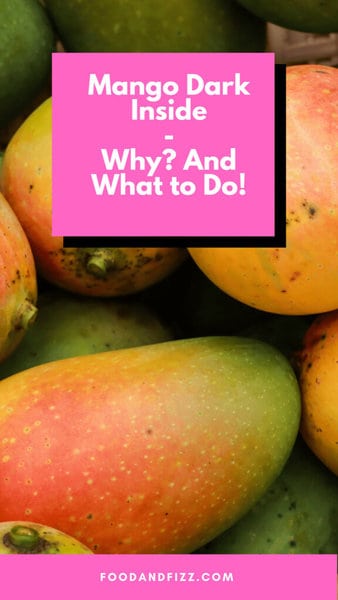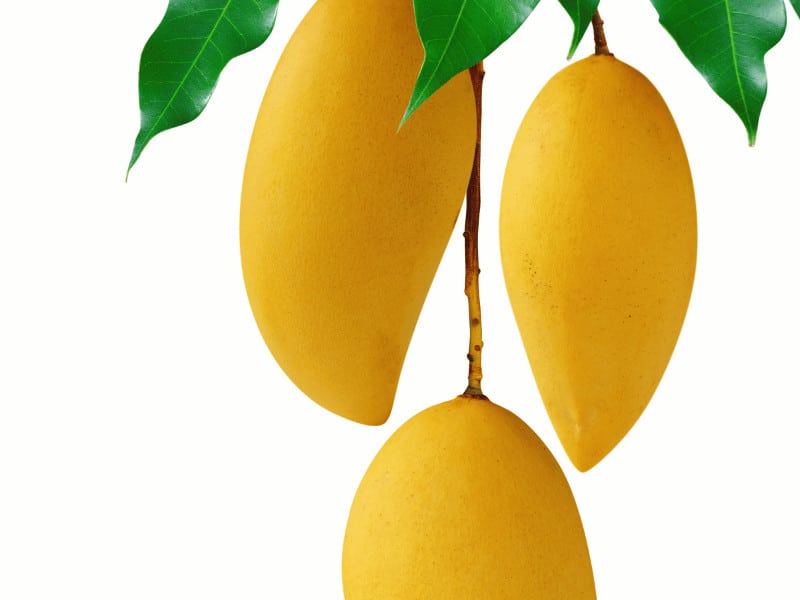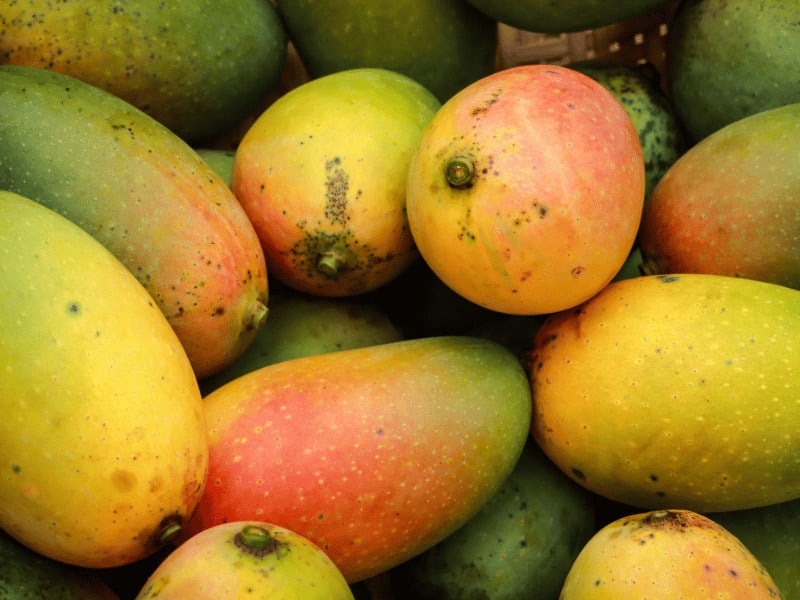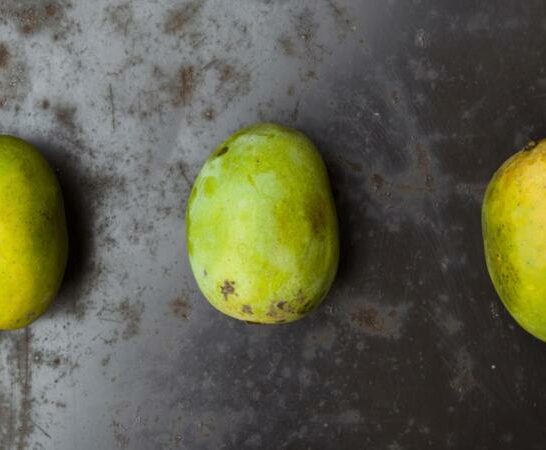Your mango is dark inside. Mango fruit that is turning brown or purple is still safe to eat in most cases. But it can often taste bad. In this article, I will outline all the possible reasons for brown and black spots on a mango.
I often buy mangoes. Mostly they are fresh and firm when bought. But then they deteriorate quickly and become soft. If you wait a bit longer, the flesh inside even gets dark.
Mangos contain many beneficial nutrients, like vitamins C, A, E, and potassium. So I am often reluctant to toss a mango that looks darker than usual inside.
Here is why they turn brown and black and what you need to know.
Mango Dark Inside
A mango turns dark inside because of bruises, from the soaking process in hot water, from being overripe, because of a fungal or insect infestation, and because of sunburn.
Brown or purple mango fruit is unlikely to get you sick but will taste bad. Other signs of a bad mango include black patches on the skin, leaking liquid, a change in odor, and a soft feel to the touch.

6 Reasons Why A Mango is Black Inside
The six main reasons why mango is black inside are:
- It has bruises from handling
- It is overripe
- From the processing in hot water
- Fungal infection
- Insect infestation
- Sunburn
1. It has bruises from handling
Mangoes are often shipped from far away and are stored in multiple locations. This all happens before you can buy them in the store. During their journey from the tree to your table, they might fall or be pressed too hard against each other or other objects. This can cause bruising that turns mangoes black inside.

2. It is overripe
When the mango starts to ripen, it quickly becomes overripe. Maonges at home need to be consumed within five days. Signs of brown and black inside a mango indicate that it is overripe.
3. From the processing in hot water
A lot happens to a mango when harvested from a tree and then lands on your store shelves.
Part of the processing can cause brown or purple patches inside your freshly-cut mango.
Mangos must undergo this processing to be legally imported to America and sold.
Only 2% of mangos sold in America are grown in America, according to Under the Mango Tree.
Mangos need a 90 – 120-minute bath in 115 to 120 degrees F water to kill tiny insects.
Non-organic mangos can be irradiated instead of undergoing this bath.
After the bath, the mangos are allowed to cool to room temperature for an hour, then put into refrigeration.
They undergo more processing, but the hot water bath causes those dark patches in the mango.
Some mangos begin to rot on the inside after their bath.
The dark color is caused by chemicals leaking from damaged cell membranes that react with minute traces of oxygen inside the mango.
4. Fungal infection
According to the Northern Territory Government, Anthracnose is a serious mango disease. It is caused by a fungus called Colletotrichum gloeosporioides var minor. This fungus develops when it rains a lot during flowering and when the fruits are set on the mango tree.
The fungus develops brown to grey spots in the mango flesh and skin.
5. Insect infestation
There are more than 60 different fruit fly species from the genera Anastrepha, Bactrocera, Ceratitis, and some seed and pulp weevils that affect the mango fruit, says Mango.org.
These pest insects can damage the flesh. The result is brown and black discoloration.
6. Sunburn
Mango trees love sunlight. They need at least 8 hours of direct light a day. But sunlight can lead to sunburn in combination with dry conditions and insufficient foliage on a tree to protect the mango fruits. According to Plantwise, the fruits can become stressed. This leads to brown and dark spots.

Mango Inside
The inside of a mango consists of the flesh and the pit. The outside of a mango consists of its skin.
The flesh of the mango is yellow to orange. It has a fibrous texture and a sweet smell. Mangoes are rich in vitamins C and A. They also contain lots of fiber and antioxidants, including beta-carotene and polyphenols.
The mango pit is woody and hard. It is also called a stone or seed. The mango uses it for its reproduction. Most people don’t know that the pit can also be eaten. You can ground it up and use it as a spice.
Safe Storage of Mangos
When a mango gets to your house, it’s already been weeks off the tree.
The clock is ticking for how long it will be until it rots. That being said, many mangos still arrive at the store unripe.
A ripe mango is slightly soft but not squishy.
The color of a ripe mango differs depending on the variety, so concentrate more on the feel than color, except for one color – black.
Black indicates rot, no matter what the variety.
If your mango is still unripe, the National Mango Board advises putting it in a paper bag and closing it.
Let it sit on your counter at room temperature until it is ripe.
Only then should the mango be refrigerated. Uncut mangos last for up to five days in the refrigerator.
Once the mango is cut, it spoils very rapidly. It should be used within five days if you store it in an air-tight container in the refrigerator.
Cut mango fruit can spoil if left at room temperature within a few hours.
Mangos can be frozen, but they must be cut up before freezing. The thawing process affects the taste.
Frozen mangos can last up to one year but tend to clump.
To avoid this, arrange the cut mango fruit in a single layer in a pan or shallow dish and place it in the freezer for a few hours.
This makes the mango chunks firm enough not to stick to their neighbors.
You can then place the chunks into a plastic freezer bag or another container.
After thawing, mango fruit will rot as quickly as fresh fruit, so only thaw what you need so you don’t have to bang your head against the wall after cutting and freezing a mango, only for it to go bad, anyway.
Mango Brown Inside – Signs of a Bad Mango
Dark spots inside the mango are signs that the mango is starting to rot.
Dark spots in mango will not make you sick but won’t taste nice.
Signs that mango will get you sick if you eat it include:
- A bad smell, including a sour or alcoholic smell. You can smell mangos best at their stems.
- Black patches, which indicate rot.
- Mold. It’s usually white, light green, or light blue.
- Although ripe mangos have a slight give to them, they should not be squishy.
- Mangos that ooze or leak juice.

Unfortunately, there have been cases where mangos have looked, smelled, felt, and tasted just fine and yet gave people salmonella.
This was such a problem that in 2012, the Federal Drug Administration labeled mangos as “high-risk fruit.”
Salmonella only happened to people who bought whole fruits.
Salmonella outbreaks linked to mangos have gone down since the cause of the outbreaks was discovered – the hot water washes required to de-bug mangos.
According to the University of Connecticut, chlorine has been found to kill salmonella in mangos, even though it does not work for any other kinds of fruits and vegetables.
Work to make mangos salmonella-free is still ongoing.
Can you eat a Brown Mango?
You can eat a mango that is brown inside as long as it doesn’t smell foul. It will not taste very good. The reason is that it is most likely overripe, and the rotting process has already started. Foul-smelling mangoes cause stomach upset and can even lead to food poisoning.
Frequently Asked Questions
What are the Signs of a Bad Mango?
Uncut mangos that have black patches, leak fluid, are squishy to the touch, and usually smell like something other than mangos. Cut fruit changes color, smells, turn into liquid, and grows mold.
Can Mangos That Look and Smell Okay Still Get You Sick?
Mangos contain fiber, so if you eat a lot, it may give you diarrhea. Mangos are also one of the most naturally sweet fruits you can buy, which may cause blood sugar spikes in diabetics. Mangos have also been linked to salmonella outbreaks when not processed properly.
If mango is brown on the inside is it bad?
If a mango is brown inside it is most likely bad and should be discarded.
Black spots on mango is it safe to eat?
Black spots on a mango mean that it is overripe but it is still safe to eat as long as no mold has built up and it doesn’t smell sour or alcoholic.
Conclusion
Any dark spots inside of mango are a sign that the mango is starting to rot. Although the mango is safe to eat, it will taste bad. It’s best just to trash it. The dark spots are often caused by soaking in hot water to remove insects that all mangos must go through to sell in America.

